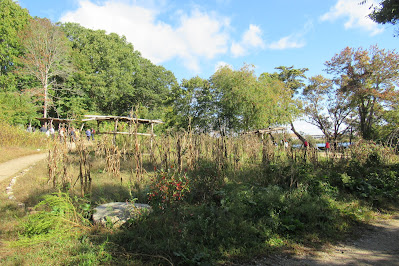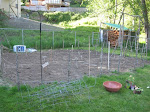Our last full-day was spent in Plymouth. We went to the Plimoth Patuxet Museum.
Patuxet is the Indigenous name of the place where the Mayflower passengers established their town. In the English sources, Patuxet is referred to more than a dozen times... In the Wampanoag language it means 'place of running water,' in reference to what today is called Town Brook, and the many natural springs in the area.
a "mishoon" next to the river
the wetu dwelling
cooking over the fire at the cooking arbor
In the Craft Center... Watch artisans practice historical crafts in a modern setting. Learn about 17th-century herbal remedies at the Apothocary and observe potters as they carefully recreate earthenware reproductions of ceramics made in 17th-century England and Europe.
Travel back in time and experience Plymouth Colony in the 1620s. Explore our recreation of the Pilgrims' settlement, interact with historical performers portraying 17th-century residents of the Pilgrims' town, and observe our heritage breeds animals. You might meet a housewife preparing a meal or be invited to join in a game. Don't be surprised if you are asked to help with daily chores such as splitting wood, fetching fresh water from the spring, or pounding corn.
Mayflower left New Plymouth in early April 1621, and arrived back in London a month later. Based on primary source evidence, Mayflower was likely broken up and sold for scrap around 1624.
Mayflower II is a full-scale reproduction of the ship that carried the Pilgrims to these shores. While no images or plans of Mayflower exist, plans for Mayflower II were created by combining information from period shipbuilding manuals and descriptions of Mayflower in primary sources. Built by hand, using the same tools and techniques as shipwrights 400 years ago, this ship crossed the Atlantic in 1957, a gift from the people of England to the United States.
At almost 65 years old, Mayflower II is a rare survivor from the golden age of reproduction shipbuilding. Between 2014 and 2020, she underwent a complete stem-to-stern restoration to remain both a working vessel and a floating classroom.
We took a walking tour of the waterfront in Plymouth.
In the fall of 1620, Mayflower carried the Pilgrims on a 66-day voyage across the stormy Atlantic Ocean. Mayflower's passengers - many of whom were Reformed Christians seeking to separate from the Church of England - left behind families, homes and livelihoods for a chance to prospe in a land unknown to them. On November 11, Mayflower dropped anchor in what is known today as Provincetown Harbor. After several weeks of searching for a suitable place to build, the Pilgrims arrived in Plymouth Harbor. This was the site of the Wampanoag community of Patuxet, left uninhabited after a devastating epidemic that swept coastal New England just before Mayflower arrived.
In the first bitterly cold winter, half of the Pilgrims fell ill and died. The following spring, they made an alliance with their Wampanoag communities, there was no turning back. Their interactions over the next 70 years, both cooperative and adversarial, have shaped the development of modern America.
Although the Pilgrims intended to settle on the western bank of the Hudson River, dangerous shoals and "contrary" winds forced the ship to remain in New England. Because the passengers were not within the bounds of their patent - or permission from the English king to settle - they would technically be outside of the law when they disembarked. Troubled by "discontented, and mutinous speeches" made by some Mayflower passengers, the Pilgrim's leaders moved quickly to quell faction. Recognizing that disunity could spell disaster for the new community, most of the male passengers signed the document we know today as the Mayflower Compact.
This document, born of great necessity, laid the foundation for the new community's civic life- and for our American system of representative government. Today, many consider the Mayflower Compact to be the oldest written compact that derives power from the consent of those it governs.
Plymouth Rock was much smaller than we expected. It turns out that people used to break pieces of it off as souvenirs.
On the way back to Boston we stopped at a brewery to kill time until we had to return the rental car.
It may have been super expensive and the last hotel room available in town but it was amazing! And the view from our room of the city skyline was gorgeous!



















































No comments:
Post a Comment